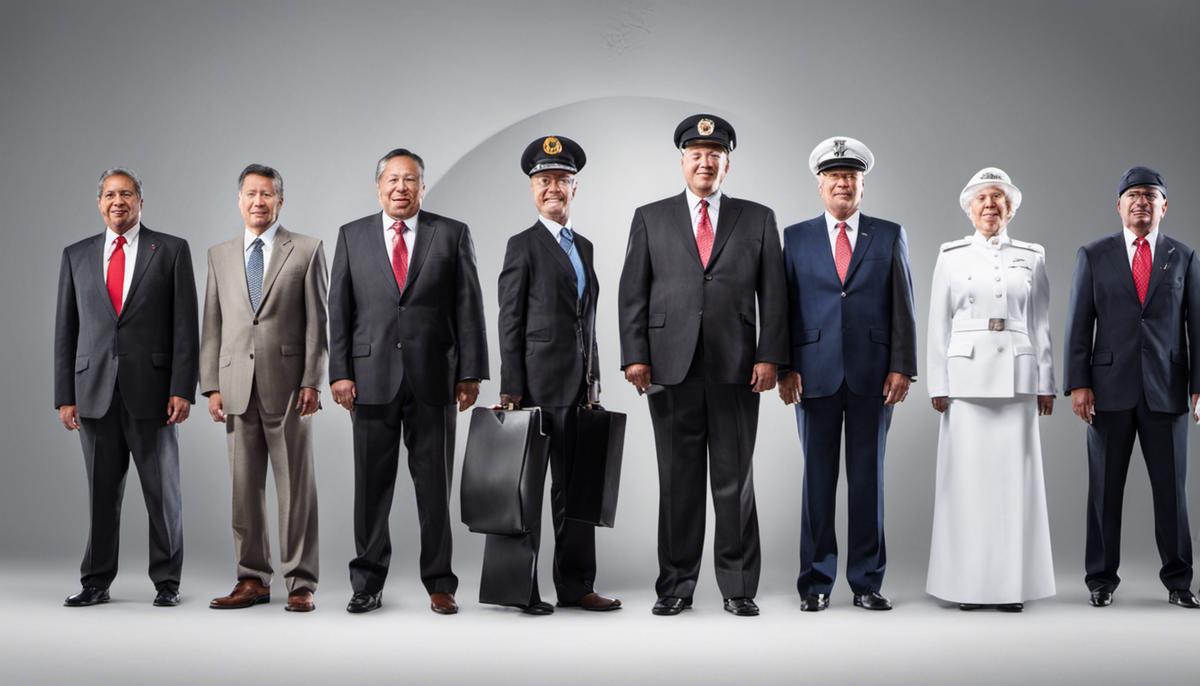In today’s ever-evolving professional landscape, leadership takes on a pivotal role in shaping organizational success. Leadership is no longer a one-size-fits-all concept; instead, it morphs into diverse styles that can effectively navigate the complexities of varying scenarios. This discourse seeks to delve into the intricate dynamics of leadership styles, their practical application, effects on performance and engagement, and the influence of culture and personality. To initiate, we build an understanding of the many leadership styles— their definition, characteristics, and significant strengths along with weaknesses. We further journey into the application of these styles across multiple industries, team performance, individuals’ job satisfaction, and how culturally diverse leaders command remarkably different leadership tactics.
Understanding Leadership Styles
Understanding Leadership Styles
Leadership styles are the different approaches that leaders use to drive their team’s performance and achieve organizational goals. These leadership strategies, or styles, vary based on the leader’s personality, industry, and team dynamics and greatly influence an organization’s culture, engagement, and productivity.
Autocratic Leadership Style
The autocratic leadership style is characterized by leaders who make decisions without consulting their team members. This leadership style is often associated with efficiency since decisions are made quickly, without the need for group discussions or debates. However, it may stifle creativity, discourage collaboration, and lead to low job satisfaction if used excessively.
Democratic Leadership Style
Democratic leadership, also known as participative leadership, is marked by the active involvement of team members in decision-making processes. This style fosters creativity, encourages team engagement, and improves job satisfaction. However, it could lead to slow decision-making processes due to the need for consensus.
Transformational Leadership Style
Transformational leaders inspire and motivate their teams to excel, often pushing them to exceed their self-set limits. These leaders tend to foster strong bonds with their teams and encourage personal and professional development. However, their high standards may create pressure and contribute to employee burnout if not properly managed.
Transactional Leadership Style
This style is built on a system of rewards and punishments. Transactional leaders provide their team with clear expectations and goals. Compliance is rewarded, often in the form of bonuses or promotions, while non-compliance is duly punished. This style is effective when tasks are structured or routine, but it may limit innovation, and it could create a culture of fear, stifling healthy risk-taking behavior.
Laissez-Faire Leadership Style
Laissez-Faire or free-reign leadership style involves leaders providing minimal direction to their team, allowing them the freedom to find their own solutions and work at their own pace. This style typically works well with highly skilled, self-driven teams but it can lead to low productivity if the team lacks direction or motivation.
Servant Leadership Style
A relatively new and increasingly popular style of leadership, Servant Leadership is about building a team, developing talent, and meeting the needs of team members. These leaders prioritize the growth, learning, and wellbeing of their followers over self-interests. While this style fosters a positive workplace culture, one potential downside is a perceived or actual decrease in authority or respect for the leader.
The Significance of Leadership Styles
The criticality of comprehending leadership styles can be found in their ability to provide leaders with the tools to adapt to the array of situations they may encounter. Each group and situation may warrant a unique approach. A leader who is capable of adjusting their leadership style proves instrumental in propelling their team towards reaching organization objectives. Knowledge of the strengths and drawbacks of each leadership style cultivates enhanced leadership prowess and organizational performance. Hence, individuals in executive roles, managers, and those seeking leadership positions must comprehend the distinct kinds of leadership styles to proficiently traverse the diverse landscapes of an organization.

Applications of Different Leadership Styles
The Autocratic Leadership Style: Exploring Its Realms
Typically, an autocratic leadership style involves a leader who makes decisions without substantial input from team members. Structured and resilient work environments are where this style thrives, delivering consistency and uniformity at its finest. Examples can be seen in businesses within the manufacturing industry that necessitate tight controls to ensure rigorous adherence to safety standards and quality control measures.
In emergency scenarios that demand rapid decision making, autocratic leaders can swiftly make efficient choices without needing to obtain consensus. This efficiency in decision-making can help to simplify processes, reduce potential uncertainty, and accelerate outcomes. Nevertheless, if this style is over-utilized, it could result in a dampening of team morale and creativity.
Democratic Leadership Style and Its Application
Democratic leadership encourages team members’ participation in decision-making processes. This style can be applied successfully in settings where creativity, innovation, and team engagement are essential. For instance, in tech startups or creative agencies, where novel ideas and problem-solving approaches are beneficial, a democratic leadership style can motivate employees.
Democratic leadership can also be beneficial in academic or research settings where intellectual diversity and collaborative problem solving are critical to success. This form of leadership encourages a sharing culture, enhancing individuals’ skill-sets, and thus, improving the satisfaction levels of team members.
Transformational Leadership Style and Its Application
Transformational leaders inspire and motivate their team members to exceed their own individual performance goals by fostering professional development and personal growth. This leadership style is particularly effective in fast-paced and volatile industries such as digital marketing or financial services. Teams working in these environments need a leader who can constantly inspire them to adapt and evolve according to dynamic market trends.
Companies undergoing significant change or restructuring can also benefit from transformational leadership. For example, during a merger or acquisition, transformational leaders can effectively convey their vision for the integration, mitigating resistance to change, and encouraging buy-in from employees.
Exploring Laissez-faire Leadership Style and Its Usage
A laissez-faire leadership style offers the ultimate freedom to team members by granting them the autonomy to make independent decisions and problem-solving. This leadership approach thrives in environments where team members possess a high level of expertise, experience, and self-drive. Research and development teams or highly-specialized consultant groups, for instance, may prosper under a laissez-faire leader, given their necessity for independence to foster innovation and achieve exceptional results.
This style of leadership can be equally beneficial in creative industries such as advertising or graphic design. Granting creative professionals the liberty to fully express their distinctive ideas without overbearing interference can fuel innovative designs and revolutionary advertising campaigns.

Influence of Culture and Personality on Leadership Style
Discerning the Influence of Culture on Leadership Styles
Cultural factors considerably influence leadership styles as personal upbringing, environments, norms, values significantly shape individuals. For examples, leaders originating from collectivist societies, like those in East Asia, are likely to adopt a participative leadership style that prioritizes the broader group’s objectives over individual ones. Conversely, leaders hailing from individualistic societies, such as the United States or Europe, are typically inclined towards a transactional leadership style, which emphasizes personal achievements and merit.
Influence of Personality on Leadership Style
Personality traits also substantially impact leadership styles, defined by the leader’s innate dispositions and characteristics. For instance, leaders with high extraversion tend to exhibit a more charismatic or transformational style due to their level of assertiveness and outgoingness. Conversely, those with a high degree of openness are often more democratic, seeking and appreciating diverse viewpoints before making decisions.
The Complexities of Diversity in Regards to Leadership Styles
The increasing global interconnection of businesses necessitates leaders to manage and lead teams with diverse cultural and personality differences. Largely, this includes understanding and resonating with their team members’ values and habits, fostering a respectful and inclusive environment that cultivates creativity and innovation.
Embracing Adaptive Leadership
The ability to be flexible and adapt a leadership style fitting to a variety of cultural contexts and personalities is known as adaptive leadership. An adaptive leader recognizes the diverse backgrounds of their team members and adjusts their style to ensure they resonate with everyone. They promote cultural sensitivity and inclusion, creating an environment where everyone feels valued.
In a hyper-globalized world, understanding the substantial influence of culture and personality on leadership styles is essential for any professional. Leaders who successfully adapt to cultural contexts and the unique individual personalities at their disposal are not only more effective but also cultivate an environment of inclusivity, innovation, and peak performance.

Leadership Style Impact on Employee Performance and Engagement
How Leadership Styles Affect Employee Performance
One of the factors in an organization that has a profound impact on employee performance and productivity is the leadership style in effect. Varying leadership styles can dramatically affect the morale and productivity of the workforce. Consider the autocratic style of leadership, for example, which is marked by consolidated decision-making power with management. This tends to stifle employee creativity and autonomy, potentially leading to reduced workforce productivity and job satisfaction. On the other hand, a transformational leadership style can motivate employees to go above and beyond their personal performance goals, ultimately leading to an increase in overall productivity.
Adaptive Leadership and Employee Engagement
Adaptive leadership style is characterized by a leader who encourages employees to step out of their comfort zones and adopt new strategies to adapt to changing organizational scenarios. This type of leadership boosts employee morale by encouraging involvement and promoting innovation. The flexibility and adaptability of this style significantly improve employee engagement and overall job satisfaction.
Democratic Leadership and Job Satisfaction
Another leadership style that positively affects employee performance and engagement is the democratic leadership style. Leaders following this approach promote participation from every team member in decision-making processes, boosting their sense of responsibility and commitment to the task at hand. Research has shown that this inclusion contributes significantly to job satisfaction, improving overall team morale and resulting in better performance.
Transactional Leadership’s Impact on Employee Performance
Transactional leaders operate on the system of rewards or punishments, creating a clear structure and chain of command. While this style can ensure consistency, it can stifle creativity and innovation. Over-reliance on rewards can also lead to reduced performance when the reward system is not in place.
Laissez-faire Leadership and Employee Engagement
The laissez-faire leadership style grants employees high levels of autonomy. This can increase job satisfaction, particularly among self-driven and highly-skilled employees. However, if not managed correctly, it can lead to a lack of direction and engagement, reducing overall team productivity.
Transformational Leadership and Enhanced Performance
Transformational leaders inspire their team members to exceed their own expectations, motivating them to continuously improve their performance. Such leaders foster a supportive environment that nurtures creativity, individual development, and innovation. This style cultivates an engaged workforce and typically results in high levels of productivity and job satisfaction.
Leadership styles take on various forms, each resonating differently when it comes to employee performance, engagement, and job satisfaction. As such, it’s critically important for organizations to pinpoint and cultivate a leadership style that aligns optimally with both their team dynamics and overarching objectives.

Developing Your Own Leadership Style
Parsing the Landscape of Leadership Styles
Leadership styles span the gamut, each bearing their own unique set of strategies, methodologies, advantages, and potential pitfalls. Among the most recognized of these approaches are participative, authoritarian, transformational, transactional, laissez-faire, and servant leadership. Having a firm grasp of these diverse leadership styles is a fundamental stepping stone for professionals looking to make strong impacts as leaders. By delving into the different styles, one can decipher which approach harmonizes best with their personal style, the dynamics of their team, and the culture of their organization.
Evaluating Your Natural Leadership Style
Begin developing your style by evaluating your natural leadership tendencies. Are you more inclined towards participative leadership where team input is valued? Or do you lean towards an authoritarian style, where decision-making is concentrated at the top? Perhaps you prefer a laissez-faire approach and give your team plenty of autonomy? Self-assessment tools such as personality tests, 360-degree feedback, or structured leadership style assessments can also aid this process.
Adapting to Various Situations: Situational Leadership Style
Effective leadership is not rigid but dynamic. Depending on the situation, it could be beneficial to adapt different leadership styles. For example, a situational leadership style calls for adapting your leadership style according to the team’s maturity, the complexity of the task, and the organization’s environment. Therefore, situational awareness is key to being an effective leader, and it can be cultivated through continuous learning, observation, and experience.
Developing An Authentic Leadership Style
Equally essential is authenticity in leadership. Authenticity refers to staying true to one’s values, strengths, and beliefs while leading. Leaders should avoid imitating other leaders’ styles. Instead, use them as inspiration to guide you in developing your own. It can be beneficial to seek a coach or mentor’s guidance in this process, as they can provide advice and feedback based on their own experiences.
Continuous Learning and Improvement
To become an effective leader, understand that your leadership style should not stagnate. Regular reflection on your practices, successes, and challenges enables growth and development. Keep abreast with the latest leadership trends, take leadership training courses, and always be open to feedback.
Developing Emotional Intelligence
Emotional intelligence is a critical component of effective leadership. It enables leaders to understand and manage their emotions and of those around them. Emotional intelligence can enhance various leadership styles as it promotes better communication, conflict resolution, team collaboration, and decision-making. Cultivate emotional intelligence through mindfulness techniques, empathy training, and emotional regulation exercises.
Adapting Your Leadership Style to Match Your Team and Organization’s Culture
Finally, adapting your leadership style to match your team and organizational culture is pivotal to effectiveness. Understand the values, beliefs, and norms that guide your team and organization and shape your leadership style to align with these. This alignment promotes understanding, cohesion, and productivity on your team.

Embarking on the journey of leadership is not about adopting a static style—it is about a constant evolution and adaptation based on the leader’s personality, the team, and the organizational culture. This discourse serves to guide professionals into developing their own unique leadership style, drawing from the various styles discussed herein, and molding them to suit individual personality traits and specific organizational needs. In essence, effective leadership is an introspective journey that involves both self-assessment and attuned perception of one’s environment. It takes courage and insight to create and lead with a style that rings true to one’s values, respects diversity, and cultivates productivity and enthusiasm within a team. Remember, leadership is not a destination but a continuous journey of learning, adapting, and influencing.
